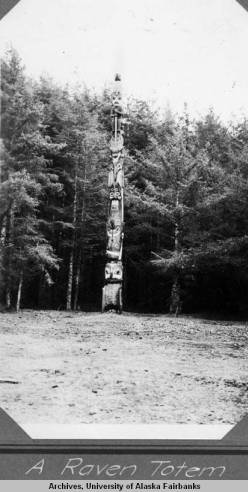- City:
- Sitka, AK
- Site Type:
- Archaeology and History, Art Works, Sculptures, Historical Restoration
- New Deal Agencies:
- Civilian Conservation Corps (CCC), Work Relief Programs, Works Progress Administration (WPA)
- Started:
- 1938
- Completed:
- 1941
- Artists:
- George Benson (Lkeináa), Haida craftsmen, Tlingit craftsmen
- Quality of Information:
- Very Good
- Site Survival:
- Extant
Description
The Civilian Conservation Corps (CCC) carved a copy of the original Gaanax.ádi/Raven Crest Pole during a restoration program that lasted between 1938 and 1941. The pole was donated in 1903 and brought to Sitka from Tuxekan. The restoration was part of a larger U.S. Forest Service program focused on the conservation of totems and Native cultural assets. Many of the poles that the CCC recovered were found in an advanced state deterioration, which made conservation difficult. While restoration was the preferred approach, the CCC opted for recarving, or partial recarving, if the pole could not be salvaged. The head carver at Sitka was George Benson (Lkeináa). The post currently at the Sitka National Historical Park is a 1983 copy of the original post from Tuxekan. The CCC post, also a copy of the original, is currently held on site at the Totem Conservation Exhibit.
Before the CCC program, many totems had been left to deteriorate in abandoned villages, as Native populations began to migrate in search of work opportunities. Leaving old totems to rot away was a longstanding Native practice. However, few new poles replaced the deteriorating ones in the early twentieth-century, as the art of totem carving gradually disappeared due to outmigration. In his 2012 volume, The Most Striking of Objects: The Totem Poles of Sitka National Historical Park, Andrew Patrick notes that the conversion of many Natives to Christianity also contributed to the disappearance of carving traditions. Citing Alison Hoagland (1997, 182), Patrick writes that young Natives from the village of Kake got together to destroy the poles and the bones of the dead with dynamite, while the elders watched in dismay. The new CCC program enlisted the help of master carvers such as George Benson, and began to train young recruits in the craft of totem carving, thus helping preserve not only Native artifacts, but also cultural practices.
In the volume The Most Striking of Objects, Andrew Patrick describes how the New Deal brought an influx of WPA and CCC funding, which helped with the conservation of the totem poles at Sitka: “The involvement of the WPA and the CCC with Sitka’s totem poles began in January 1939. [B. Frank] Heintzleman secured WPA funding for totem pole restoration at Sitka National Monument. Work began on February 18th when Assistant Regional Forester Charles Burdick assessed, photographed, and numbered the poles. […] Funding switched from the WPA to the CCC just a month after the work first began. […] By March 22nd, 1940, all of the totem poles, except for Saanaheit’s which was still being recarved, had been refurbished or replaced.”
The National Park Service information page for the Sitka National Historical Park summarizes the characteristics and history of the figures represented on the Saanaheit Pole: “This is a 1983 reproduction of the original pole donated in 1903 by Chief Gunyah of the Tlingit village of Tuxekan. Tlingit artist Nathan Jackson (Yéilch Ya’di) and noted carver Steve Brown (Kaajísdu.áxch) used early photographs by E. W. Merrill from the park collection to reproduce the details of the original pole. Compare this reproduction with the Civilian Conservation Corps replica of the same pole in the covered Totem Conservation Exhibit near the upper Totem Loop trailhead.
It is unclear whether this is a story pole or a crest pole. One legend, called Raven and the Whale, is suggested by the figure of the whale near the center of the pole.”
Source notes
National Park Service, Sitka National Historical Park, Totem Trail, accessed August 24, 2017. National Park Service, Sitka National Historical Park, Frog/Raven Pole, accessed August 24, 2017. Larry Rakestraw, Totem Pole Restoration, Interview with Linn A. Forrest, August 1, 1971. Hoagland, Alison K. "Totem poles and plank houses: reconstructing native culture in southeast Alaska." Perspectives in Vernacular Architecture 6 (1997): 174-185. Patrick, Andrew. "The most striking of objects: the totem poles of Sitka National Historical Park." (2002), p. 104-121.Site originally submitted by Brent McKee on August 25, 2017.
At this Location:
- Sitka National Historical Park, The Mosquito Legend Pole - Sitka AK
- Sitka National Historical Park: Lakich’inei Pole - Sitka AK
- Sitka National Historical Park, Trader Legend Pole - Sitka AK
- Sitka National Historical Park, Frog/Raven Pole - Sitka AK
- Sitka National Historical Park, Saanaheit Pole - Sitka AK
- Sitka National Historical Park: Totem Conservation Exhibit - Sitka AK
View all sites at Sitka National Historical Park - AK (7 Sites)
Contribute to this Site
We welcome contributions of additional information on any New Deal site.
Submit More Information or Photographs for this New Deal Site

Join the Conversation